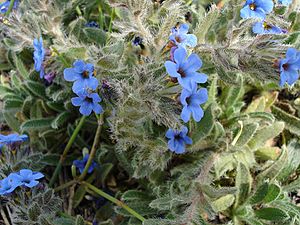Dyer's alkanet facts for kids
Quick facts for kids Alkanet |
|
|---|---|
 |
|
| Dyer's bugloss | |
| Scientific classification | |
| Genus: |
Alkanna
|
| Species: |
tinctoria
|
Alkanna tinctoria, often called alkanet or dyer's alkanet, is a special plant from the borage family. It's most famous for its roots, which are used to make a beautiful red dye. People also call it dyers' bugloss or Spanish bugloss. This plant grows naturally in the Mediterranean region.
Contents
What is Alkanet?
Alkanet plants have bright blue flowers. The root of the plant looks black on the outside. But if you cut it open, it's blue-red inside with a white center. This root is where the amazing red color comes from. People have used this dye in the Mediterranean area for a very long time.
How the Dye Works
The red color from the alkanet root dissolves well in things like alcohol, ether, and oils. However, it does not dissolve in water. This makes it useful for coloring many different products.
Uses of Alkanet Dye
The dye from alkanet roots is used in many ways:
- It adds color to wines and other drinks made with alcohol.
- It gives color to vegetable oils.
- It is used in varnishes to add a tint.
- When powdered and mixed with oil, it becomes a wood stain. This stain gives wood a dark red-brown color, similar to rosewood. It also helps to show off the natural patterns in the wood.
Alkanet in Food
In India, alkanet is traditionally used in food. It is known there as ratan jot. It gives a red color to some types of the curry dish called rogan josh. In Australia, it is allowed as a food coloring. But in the European Union, it is not approved for use in food.
Alkanet in Cosmetics
Alkanet has also been used to add color to makeup. It can be found in products like lipstick and rouge.
The Science of Its Color
The color of alkanet dye can change depending on its environment. If the dye is in an alkaline (basic) liquid, it looks blue. If you add an acid to it, the color changes to crimson (a deep red). For example, the color is red when the pH is 6.1. It turns purple at pH 8.8 and blue at pH 10. The main chemical that gives alkanet its color is called alkannin.
Other Uses
In traditional medicine, alkanet has been used to help treat abscesses (small pockets of infection) and inflammations (swelling and redness).
About the Name Alkanet
In the past, especially in medieval England, the name "alkanet" usually meant A. tinctoria. Over the years, people started using the name "alkanet" for other plants that are related to it. You can learn more about these other plants by looking up Alkanet.
See also
 In Spanish: Algamula real para niños
In Spanish: Algamula real para niños

